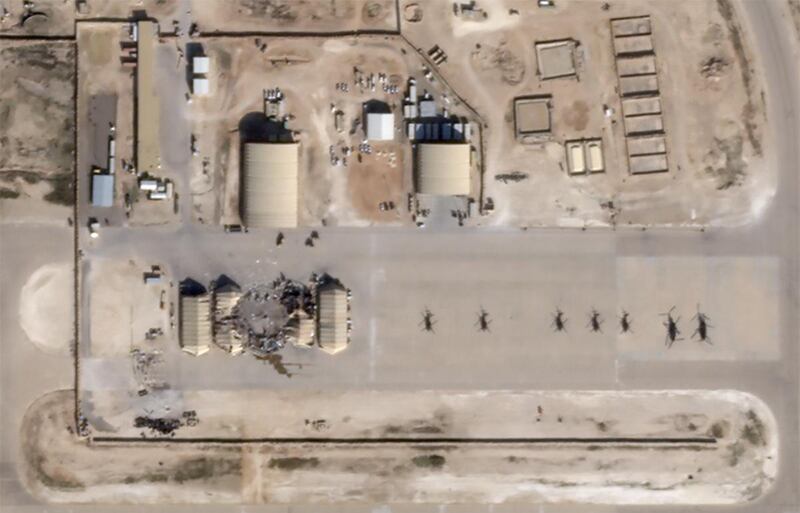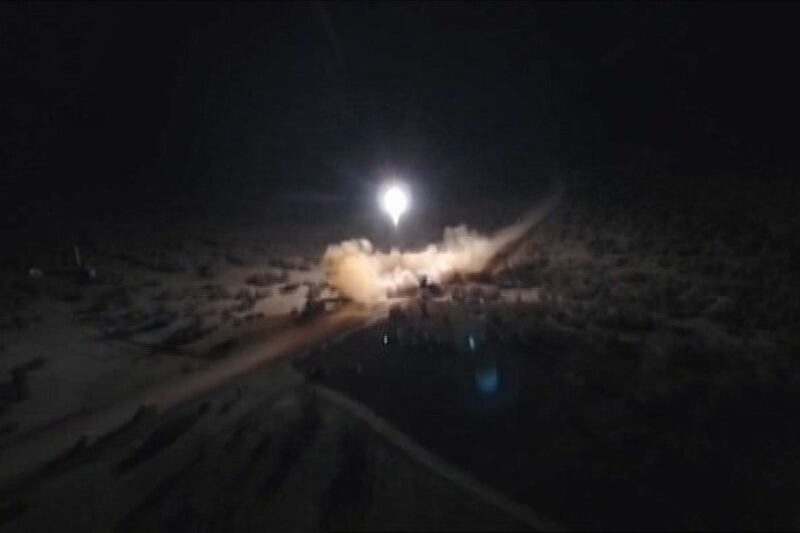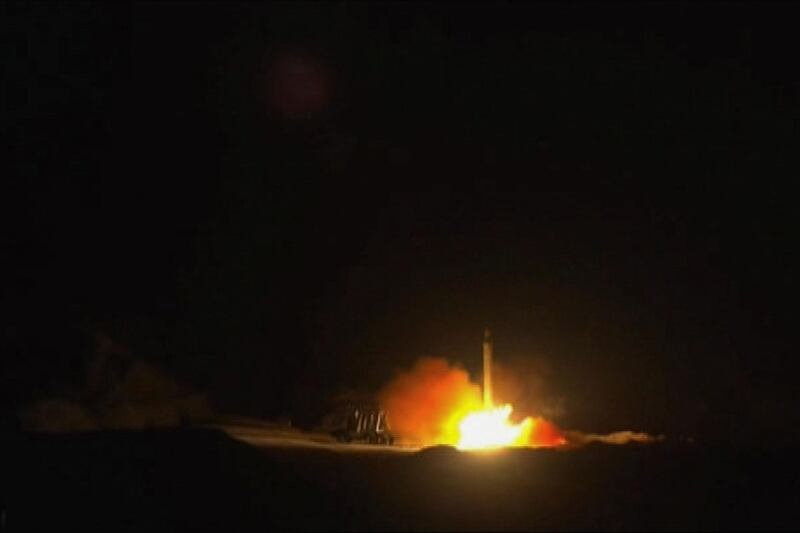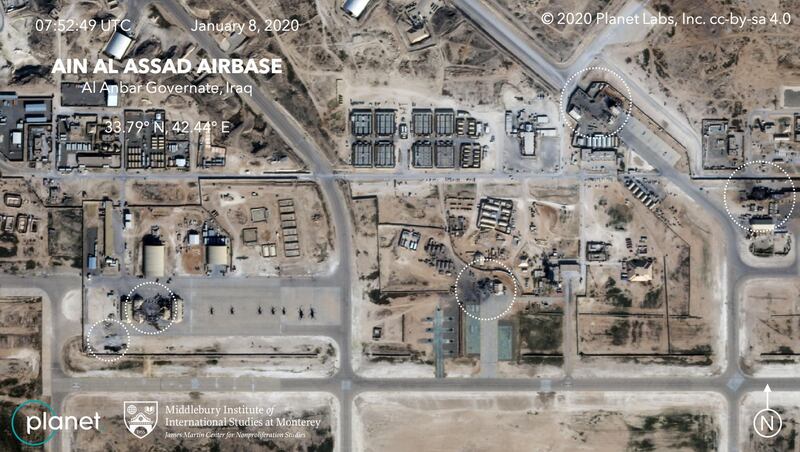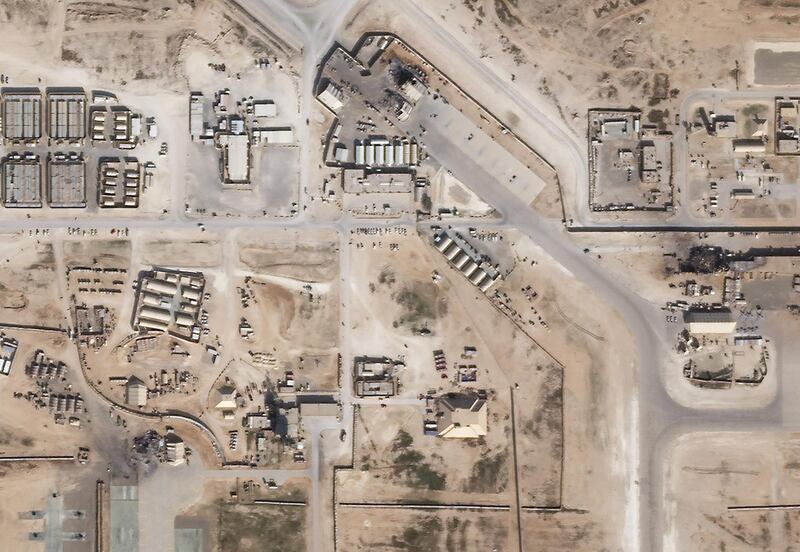A year ago on January 8, Iran launched Operation Martyr Suleimani, firing a salvo of ballistic missiles at two US bases in Iraq.
The attacks were in revenge for the death of Iranian general Qassem Suleimani, killed in a US drone strike on January 3 near Baghdad airport, after escalating violence between Iran-backed Iraqi militias and US forces.
The ballistic missile attacks were unprecedented, almost sparking a regional war – until that point, Iran had not directly attacked US forces, instead relying on allied Iraqi militias.
Eleven missiles smashed into the Iraqi-American base at Al Asad, blasting aircraft hangers to smithereens and cutting off communications to US drones, nearly causing the multi-million dollar aircraft to crash.
But after a warning was conveyed to the Iraqi government that the attack would take place, soldiers had hours to evacuate aircraft and personnel.
As missiles were launched, a military satellite system known as the Space Based Infrared System (SBIRS) detected the missiles in flight.
More than 100 US personnel sheltering in Saddam-era concrete bunkers suffered what medics call “traumatic brain injury” or TBI, which President Donald Trump later dismissed as “headaches.”
Many of the soldiers were taken to a military hospital in Landstuhl, Germany, for specialist care.
The explosive force of the impacts was enough to buckle reinforced bunker doors.
Traumatic brain injury
“TBI has been called the ‘signature wound’ of the War on Terror,” according to Warner Anderson, former associate dean of the US Joint Special Operations Medical Training Centre.
A veteran of the Iraq war and former director of international health at the US Department of Defence, Dr Anderson says TBI rose to prominence as the US fought long insurgencies in Iraq and Afghanistan.
Until the Al Asad attacks, those conflicts were characterised by roadside bombings of US and allied vehicles.
Even if armour protected infantry from visible injury, soldiers caught in roadside bombings were subjected to tremendous kinetic forces, described by one veteran as like being kicked by a giant horse.
“The US military's understanding of the injury grew with experience, and was also somewhat informed by the National Football League's struggles to come to grips with chronic traumatic encephalopathy,” says Dr Warner, referring to the growing understanding that contact sports can accumulate damage to the brain.
Dr Warner says the news that scores of American soldiers were quickly diagnosed with TBI after Al Asad shows how far understanding of the condition has come.
“At the time of entry into the Gulf War in 1991, TBI was not considered a ‘real’ wound, and was not eligible for the Purple Heart, the ‘wound badge'," he says.
“This was changed as it became better appreciated that a major concussion, or serial minor concussions, can cause lasting disability and even premature death – or dementia,” he says.
By January 30, 64 US servicemen had been diagnosed with TBI from the Al Asad attack, more than half of whom managed to return to duty within the month. Sixty were awarded “Purple Hearts,” according to the Pentagon.
But because of the nature of TBI, it is feared that many of the injured personnel could suffer neurological problems for years.
“Thick walls would certainly dampen the blast effects,” says Dr Warner, referring to the sturdy bunkers at Al Asad.
“On the other hand, a blast wave that enters a bunker-like space would ‘echo’ from one wall to another, with repeated, almost instantaneous overpressure effects.”
For soldiers unlucky enough to be close enough to explosive “overpressure”, the kinetic force can be powerful enough to fracture a human skull – although in such cases the soldiers exposed may lack sufficient overhead protection such as a sturdy bunker roof.
Surprising accuracy
The Al Asad attacks also stunned observers who believed the US could be losing its qualitative military edge.
"The accuracy revolution is real and no longer a monopoly of the United States. This has huge implications for modern conflict," said Vipin Narang of the Massachusetts Institute of Technology, in remarks to The Economist.
Mark Pyruz, an expert on Iranian political and military issues who runs the website Intel on Iran, disagrees. He believes the attack’s accuracy should not have been a shock.
“On a number of occasions the Iranians have employed their ballistic missile precision strike capability– each time as a retaliatory action,” he says.
“Iran's missile attack against Kurdish rebels at Koya in Iraq in September 2018 left no doubt the Iranians had achieved an effective precision strike capability, as independently published images confirmed impact accuracy and destructive result,” he says.
According to Mr Pyruz, while Iran may have displayed improved capability in the Koya and Al Asad attacks, Tehran was nonetheless wary of triggering a powerful US response in the latter instance.
He compares Al Asad to a prior missile attack launched by Saddam Hussein on US forces during the 1991 Gulf War, when Saddam’s regime was already being pounded by US airpower.
Under fierce bombardment, Saddam had nothing to lose, unlike Iran, which may have been avoiding US casualties by forewarning of the attack.
“Al Asad was a different experience to the 1991 Iraqi Scud strike on US Army barracks at Dhahran, Saudi Arabia, where the time between the sounded alarm and impact was around 13 minutes. The result then was 28 soldiers dead, 110 hospitalised and 150 experiencing minor physical injuries or subsequent mental health problems,” he says.
“But for the 2020 Iranian missile strikes, according to a report released by Afcent [US Air Forces Central], our US service members had hours to react. Casualties in this instance were limited to 110 US military personnel experiencing TBI.”
“Circumstance and Iranian intent may have been factors for this unusual notification and relatively lengthy preparatory time,” Mr Pyruz said, suggesting Iran was wary of provoking a wider conflict.
